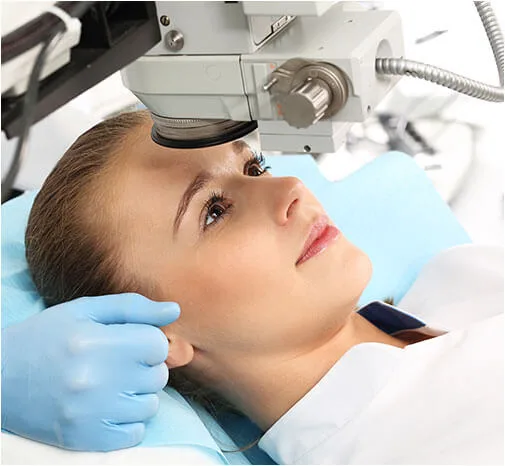Fuchs’ Dystrophy

FUCHS’ DYSTROPHY
Fuchs’ dystrophy causes the clear layer (cornea) on the front of your eye to swell. The disorder can lead to glare, cloudy vision and eye discomfort.
Fuchs’ dystrophy usually affects both eyes and can cause your vision to gradually worsen over years. But most people with Fuchs’ dystrophy don’t develop symptoms until they reach their 50s or 60s.
Some medications and self-care steps may help relieve your Fuchs’ dystrophy signs and symptoms. But when the disorder is advanced and you’ve lost vision, the only way to restore vision is with cornea transplant surgery.
Symptoms
As the disease progresses, Fuchs’ dystrophy symptoms, which usually affect both eyes, might include:
- Glare, which can decrease your vision in dim and bright light.
- Blurred vision, which occurs in the morning after awakening and gradually improves during the day. As the disease progresses, blurred vision either can take longer to improve or doesn’t improve.
- Pain or grittiness from tiny blisters on the surface of your cornea.
Other symptoms can include distorted vision, sensitivity to light, difficulty seeing at night and seeing halos around lights.
When to see a doctor
If you have some of these symptoms, and especially if they worsen over time, see an eye care provider, who might then refer you to a corneal specialist. If symptoms develop suddenly, call for an urgent appointment. Other eye conditions that cause the same symptoms as Fuchs’ dystrophy also require prompt treatment.
Causes
Normally, the cells lining the inside of the cornea (endothelial cells) help maintain a healthy balance of fluids within the cornea and prevent the cornea from swelling. But with Fuchs’ dystrophy, the endothelial cells gradually die, resulting in fluid build-up (oedema) within the cornea. This causes corneal thickening and blurred vision.
Fuchs’ dystrophy can be inherited. The genetic basis of the disease is complex — family members can be affected to varying degrees or not at all.
Risk factors
Factors that increase your risk of developing Fuchs’ dystrophy include:
- Sex. Fuchs’ dystrophy is slightly more common in women than in men.
- Genetics. Having a family history of Fuchs’ dystrophy increases your risk.
- Age. Although there’s a rare early-onset type of Fuch’s dystrophy that begins in childhood, typically the disease starts in the 20s and 30s, with symptoms developing in the 50s and 60s.
Smoking and having diabetes might also put you at higher risk of the disease.
Diagnosis
Besides testing your vision, your doctor might also have you undergo the following tests to determine whether you have Fuchs’ dystrophy:
- Staging. Your doctor will try to determine the stage of your condition by examining your eye with an optical microscope (slit lamp). He or she will then study the cells lining the back of your cornea (endothelial cells). Irregular bumps (guttae) on the back of the cornea might indicate Fuchs’ dystrophy.
- Corneal pressure test. After numbing your eyes with drops, your doctor will briefly touch your eyes with a special instrument that measures eye pressure. This test can help distinguish between a disease that increases pressure in your eye (glaucoma) and Fuch’s dystrophy.
- Corneal thickness. Your doctor might use a special instrument to measure the thickness of the cornea.
- Corneal cell count. Sometimes your doctor might use another special instrument to record the number, shape and size of the cells that line the back of the cornea.
Treatment
Some nonsurgical treatments and self-care strategies might help relieve the symptoms of Fuchs’ dystrophy. If you have severe disease, your doctor might suggest surgery.
Medications and other therapies
- Eye medication. Eyedrops or ointments can help reduce the amount of fluid in your cornea.
- Soft contact lenses. These act as a covering to relieve pain.
Surgery
People who have surgery for advanced Fuchs’ dystrophy can have much better vision and remain symptom-free for years afterward. Surgical options include:
- Replacing the inner layer of the cornea. This replaces the back layer of the cornea with healthy tissue from a donor. The procedure is usually done with local anaesthesia in an outpatient setting.
- Transplanting the cornea. This surgical procedure, known as penetrating keratoplasty, replaces the full-thickness cornea with a healthy one from a donor. Although not used much anymore for Fuchs’ dystrophy, it might be the best choice in some cases.


